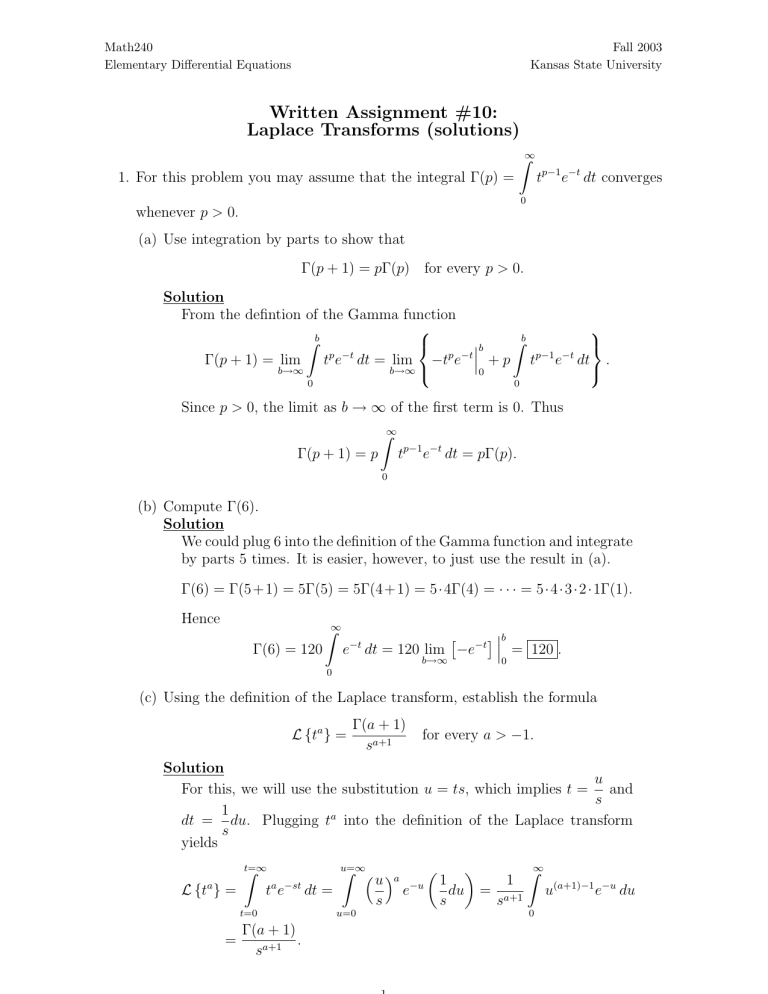Written Assignment #10: Laplace Transforms
advertisement

Math240
Elementary Differential Equations
Fall 2003
Kansas State University
Written Assignment #10:
Laplace Transforms (solutions)
1. For this problem you may assume that the integral Γ(p) =
Z∞
tp−1 e−t dt converges
0
whenever p > 0.
(a) Use integration by parts to show that
Γ(p + 1) = pΓ(p) for every p > 0.
Solution
From the defintion of the Gamma function
Zb
Zb
¯b
¯
Γ(p + 1) = lim
tp e−t dt = lim −tp e−t ¯ + p tp−1 e−t dt .
b→∞
b→∞
0
0
0
Since p > 0, the limit as b → ∞ of the first term is 0. Thus
Γ(p + 1) = p
Z∞
tp−1 e−t dt = pΓ(p).
0
(b) Compute Γ(6).
Solution
We could plug 6 into the definition of the Gamma function and integrate
by parts 5 times. It is easier, however, to just use the result in (a).
Γ(6) = Γ(5+1) = 5Γ(5) = 5Γ(4+1) = 5·4Γ(4) = · · · = 5·4·3·2·1Γ(1).
Hence
Γ(6) = 120
Z∞
e
−t
¤ ¯¯b
dt = 120 lim −e ¯ = 120 .
b→∞
0
£
−t
0
(c) Using the definition of the Laplace transform, establish the formula
L {ta } =
Γ(a + 1)
sa+1
for every a > −1.
Solution
u
For this, we will use the substitution u = ts, which implies t = and
s
1
a
dt = du. Plugging t into the definition of the Laplace transform
s
yields
L {ta } =
t=∞
Z
ta e−st dt =
t=0
=
Γ(a + 1)
.
sa+1
u=∞
Z
u=0
³ u ´a
s
e−u
µ
1
du
s
¶
=
1
sa+1
Z∞
0
u(a+1)−1 e−u du
n
(d) Find L t
− 21
o
. Note that Γ( 21 ) =
√
π.
(e) Apply part(a) to show that Γ(n + 1) = n! whenever n is a nonnegative integer.
Solution
Note that Γ(1) = 1, so part (a) implies
Γ(n + 1) = nΓ(n) = nΓ((n − 1) + 1) = n · (n − 1)Γ(n − 1) = . . .
= n(n − 1)(n − 2) · · · 2 · 1 · Γ(1) = n(n − 1)(n − 2) · · · 2 · 1
= n!.
2. Establish the following four transforms.
f (t) = L−1 {F (s)}
F (s) = L {f (t)}
eat cosh(bt)
s−a
(s − a)2 − b2
eat sinh(bt)
b
(s − a)2 − b2
tn cosh(bt), n a positive integer
n! (s + b)n+1 + (s − b)n+1
·
2
(s2 − b2 )n+1
tn sinh(bt), n a positive integer
n! (s + b)n+1 − (s − b)n+1
·
2
(s2 − b2 )n+1
¡
¢
¡
¢
Recall that cosh(bt) = 12 ebt + e−bt and sinh(bt) = 21 ebt − e−bt .
Solution
Using the definition of cosh(bt) and the table on page 139 in the text
·
¸
© at
ª 1 © (a+b)t ª 1 © (a−b)t ª 1
1
1
L e cosh(bt) = L e
+ L e
=
+
2
2
2 s − (a + b) s − (a − b)
·
¸
1 s − (a − b) + s − (a + b)
s−a
=
=
.
2 ((s − a) − b)((s − a) + b)
(s − a)2 − b2
Similarly
·
¸
1
1 © (a+b)t ª 1 © (a−b)t ª 1
1
L e sinh(bt) = L e
− L e
=
−
2
2
2 s − (a + b) s − (a − b)
·
¸
1 s − (a − b) − s + (a + b)
b
=
=
.
2 ((s − a) − b)((s − a) + b)
(s − a)2 − b2
©
at
ª
Again using the table on page 139, we have
·
¸
n!
n!
1 © n bt ª 1 © n −bt ª 1
=
+
L {t cosh(bt)} = L t e + L t e
2
2
2 (s − b)n+1 (s + b)n+1
¸
·
n! (s + b)n+1 + (s − b)n+1
n! (s + b)n+1 + (s − b)n+1
=
=
·
.
2
(s − b)n+1 (s + b)n+1
2
(s2 − b2 )n+1
n
Finally,
¸
·
n!
n!
1 © n bt ª 1 © n −bt ª 1
=
−
L {t sinh(bt)} = L t e − L t e
2
2
2 (s − b)n+1 (s + b)n+1
·
¸
n! (s + b)n+1 − (s − b)n+1
n! (s + b)n+1 − (s − b)n+1
=
=
·
.
2
(s − b)n+1 (s + b)n+1
2
(s2 − b2 )n+1
n


